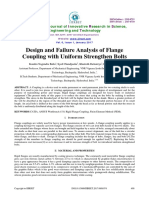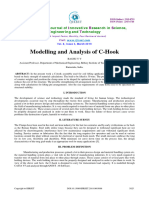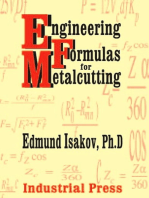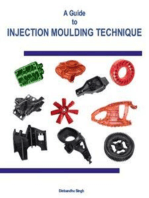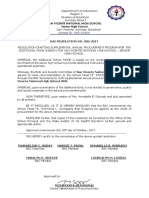Design, Analysis and Testing of Spindle For High Speed CNC Lathe Machine
Design, Analysis and Testing of Spindle For High Speed CNC Lathe Machine
Uploaded by
Arif NurrohmanCopyright:
Available Formats
Design, Analysis and Testing of Spindle For High Speed CNC Lathe Machine
Design, Analysis and Testing of Spindle For High Speed CNC Lathe Machine
Uploaded by
Arif NurrohmanOriginal Title
Copyright
Available Formats
Share this document
Did you find this document useful?
Is this content inappropriate?
Copyright:
Available Formats
Design, Analysis and Testing of Spindle For High Speed CNC Lathe Machine
Design, Analysis and Testing of Spindle For High Speed CNC Lathe Machine
Uploaded by
Arif NurrohmanCopyright:
Available Formats
ISSN(Online) : 2319-8753
ISSN (Print) : 2347-6710
International Journal of Innovative Research in Science,
Engineering and Technology
(An ISO 3297: 2007 Certified Organization)
Vol. 5, Issue 5, May 2016
Design, Analysis and Testing of Spindle
for high speed CNC Lathe Machine
Rishikesh B.Kamthe1, Chetan S.Magdum2, Aditya S. Gandhi 3, Pranav A.Naik4, Prof. P.D.Gharge5
UG Student, Department of Mechanical Engineering, NBN Sinhgad School of Engineering, Pune, Maharashtra, India1
UG Student, Department of Mechanical Engineering, NBN Sinhgad School of Engineering, Pune, Maharashtra, India 2
UG Student, Department of Mechanical Engineering, NBN Sinhgad School of Engineering, Pune, Maharashtra, India 3
UG Student, Department of Mechanical Engineering, NBN Sinhgad School of Engineering, Pune, Maharashtra, India 4
Asst. Prof., Department of Mechanical Engineering, NBN Sinhgad School of Engineering, Pune, Maharashtra, India 5
ABSTRACT: This report presents an expert CNC spindle design system strategy which is based on the efficient
utilization of past design experience, the laws of machine design, dynamics and metal cutting mechanics. The
configuration of the spindle is decided from the specifications of the workpiece material, desired cutting conditions,
and most common tools used on the machine tool. The spindle drive mechanism, drive motor, bearing types, and
spindle shaft dimensions are selected based on the target applications. The structural dynamics of the spindle are
automatically optimized by distributing the bearings along the spindle shaft. Based on maximum cutting force incurred
the analysis will be carried out. The main objective is to carry out the static analysis of spindle structure for maximum
cutting force condition and predicting life of bearings. From static analysis, stress and deformation of the spindle can be
found.
KEYWORDS: CNC, Spindle, Bearings, Maximum Cutting Forces, Static analysis.
I. INTRODUCTION
The spindle is the main mechanical component in machining centres. The static and dynamic stiffness of the spindle
directly affect the machining productivity and finish quality of the workpieces. The structural properties of the spindle
depend on the dimensions of the shaft, motor, tool holder, bearings, and the design configuration of the overall spindle
assembly. The bearing arrangements are determined by the cutting operation type, and the required cutting force and
life of bearings.
The main aim of machine tool design is to achieve long-term precision and high cutting productivity, which directly
influence the operating costs of the machine. However, increases in productivity are very often limited by chatter
occurring in the machine – tool – workpiece system. The type of cutting operation and the tool employed determine
which part of the system will be excited and which will begin to vibrate with the highest amplitude.
The performance analysis of spindle system of machine tools based on finite element analysis software includes the
following steps: creating finite element model, identifying constraints and imposing load, solving the model and
analysing the output result. In finite element analysis, for different models, analysis types and analysis methods, the
appropriate type of unit should be selected. It is necessary to take both the accuracy of the calculation and the cost
together with the time of the calculation into account. The accuracy of finite element analysis result is closely related
with the density of divided meshes. The more the mesh density is, the more the calculation accuracy is, but it also takes
higher calculation cost. When the mesh density reaches certain extent, further increased mesh density will not lead to
the improvement of the accuracy of analysis result but to doubled calculation cost. To make the mesh density achieve
the best results, it is necessary to go through trial and error.[2]
Copyright to IJIRSET DOI:10.15680/IJIRSET.2016.0505092 7282
ISSN(Online) : 2319-8753
ISSN (Print) : 2347-6710
International Journal of Innovative Research in Science,
Engineering and Technology
(An ISO 3297: 2007 Certified Organization)
Vol. 5, Issue 5, May 2016
A high speed spindle that will be used in a metal cutting machine tool must be designed to provide the required
performance features. The major performance features include:
i. Desired Spindle Power.
ii. Maximum Spindle Load - Axial and Radial
iii. Maximum Spindle Speed Allowed
iv. Tooling Style, Size and Capacity for ATC
v. Belt Driven or Integral Motor-Spindle Design
vi. High running accuracy
vii. Great stiffness
viii. Low and even running temperature
ix. Minimum need of maintenance
.
Paper is organized as follows. Section II describes Design and Analysis of Spindle Assembly.Section III presents
experimental results showing results of images . Finally, Section IV presents conclusion
II. DESIGN AND ANALYSIS OF SPINDLE ASSEMBLY
Cutting forces calculations:
Benefits of knowing and purpose of determining cutting forces-
The aspects of the cutting forces concerned:
Magnitude of the cutting forces and their components.
Directions and locations of action of those forces.
Pattern of the forces: static and / or dynamic.
Knowing or determination of the cutting forces facilitate or are required for:
Estimation of cutting power consumption, which also enables selection of the power source(s) during design
of the machine tools.
Structural design of the machine - fixture - tool system.
Evaluation of role of the various machining parameters (process - V , f , t, tool - material andgeometry,
environment - cutting fluid) on cutting forces.
Study of behavior and machinability characterization of the work materials.
Condition monitoring of the cutting tools and machine tools.
Cutting force (F ) for turning operation is calculated by,
F = Ks . f . d
Where,
K is specific cutting resistance
is feed rate (mm/rev)
d = Depth of cut (mm)
Results for Turning Operations:
For =180 m/min = 75 /
Feed ( / ) Radial Force Axial Force Torque ( ) Power ( )
( ) ( )
0.15 2207.25 1274.34 77.254 6.62
Copyright to IJIRSET DOI:10.15680/IJIRSET.2016.0505092 7283
ISSN(Online) : 2319-8753
ISSN (Print) : 2347-6710
International Journal of Innovative Research in Science,
Engineering and Technology
(An ISO 3297: 2007 Certified Organization)
Vol. 5, Issue 5, May 2016
Shaft calculations:
Shaft is a common and important machine element. It is a rotating member, in general, has a circular cross-section and
is used to transmit power. The shaft may be hollow or solid. The shaft is supported on bearings and it rotates a set of
gears or pulleys for the purpose of power transmission. The shaft is generally acted upon by bending moment, torsion
and axial force. Design of shaft primarily involves in determining stresses at critical point in the shaft that is arising due
to aforementioned loading. Other two similar forms of a shaft are axle and spindle.
Fig.1 Spindle Shaft
Shaft material= 60C4
Here, = diameter of shaft
= outer diameter of shaft
= inner diameter of shaft
= Moment at B
= Moment at A
Pulley force acts at point P and the maximum cutting force acts at L
Fig.2 Free Body Diagram
Shaft diameter:-
d = ×
(K M ) + (K M )
From above equation spindle diameter is 30mm
Bearing Calculations:
Bearing calculations were carried out as per the standard procedure using SKF Catalogue for spindle diameters starting
from 30mm. The bearing of diameter 55mm satisfies the conditions of speed and strength. But for structural
requirement we selected the bearing of diameter 60mm of BTM series, which is Super Precision Angular Contact
Thrust Ball Bearing.
Bearing Designation- BTM 60 BTN9/ P4CDB
Copyright to IJIRSET DOI:10.15680/IJIRSET.2016.0505092 7284
ISSN(Online) : 2319-8753
ISSN (Print) : 2347-6710
International Journal of Innovative Research in Science,
Engineering and Technology
(An ISO 3297: 2007 Certified Organization)
Vol. 5, Issue 5, May 2016
Deflection Calculation:
Maximum deflection of spindle was calculated using Macaulay’s method.
Maximum deflection of spindle is 0.003 mm.
CAD Modelling
Creo Parametric 2.0 was used for 3D modeling of spindle assembly.
Fig.3 Spindle assembly
The figure above shows the complete assembly of the spindle. The modelling of every part of the assembly was done
by keeping in mind all the design aspects and considerations.
Fig.4 Spindle
The spindle or shaft which is the integral part of the assembly as seen above was modelled with a lot of attention to
every detail.
The spindle was fully optimised in order to make it strong enough to withstand the forces acting on it.
Copyright to IJIRSET DOI:10.15680/IJIRSET.2016.0505092 7285
ISSN(Online) : 2319-8753
ISSN (Print) : 2347-6710
International Journal of Innovative Research in Science,
Engineering and Technology
(An ISO 3297: 2007 Certified Organization)
Vol. 5, Issue 5, May 2016
Fig.4Exploded view of spindle assembly
The above figure shows the exploded view of the assembly which consists of spindle, bearings, housing and other
parts.
Analysis
The following results were obtained after carrying out the static analysis of the spindle using Ansys.[7]
Fig.5Stress distribution
The fig. depicts the stresses induced in the spindle after applying the forces at the appropriate points.
Copyright to IJIRSET DOI:10.15680/IJIRSET.2016.0505092 7286
ISSN(Online) : 2319-8753
ISSN (Print) : 2347-6710
International Journal of Innovative Research in Science,
Engineering and Technology
(An ISO 3297: 2007 Certified Organization)
Vol. 5, Issue 5, May 2016
Fig.6 Total Deformation
The figure shows the maximum defoermation taking place after action of forces.
Result Table
Copyright to IJIRSET DOI:10.15680/IJIRSET.2016.0505092 7287
ISSN(Online) : 2319-8753
ISSN (Print) : 2347-6710
International Journal of Innovative Research in Science,
Engineering and Technology
(An ISO 3297: 2007 Certified Organization)
Vol. 5, Issue 5, May 2016
III. TESTING
Run-out (microns) Noise level(dB) Temperature(℃) Speed (rpm)
1 87.4 44.4 6175
1 76.24 41.5 4500
1 65.4 38.6 3000
1 50.25 37.6 1500
The testing was successfully carried out on the spindle assembly considering the parameters mentioned in the table
above. The spindle was mounted on the test rig and necessary clamping was provided as shown in photograph. The
spindle was driven by a motor whose maximum speed was 2580 rpm and the ratio of motor pulley to the spindle pulley
was 2.25. The designed speed of 6000 rpm was successfully reached. The run-out measured for the designed speed of
6000 rpm, on the inner surface of the spindle to check its circularity was 1 microns. Noise was measured for the same
speed using noise level meter and it was 87.4 dB which is permissible and safe for the operator. After running the
spindle at about 6175 rpm for about an hour, the temperature rise was measured using thermocouple. The rise in the
temperature was 44.4℃ which is safe for its operation.
a) Test Rig b) Run-out Measurement
c) Noise Level Measurement
The above tests a, b and c were carried out on the spindle and the results were recorded. The results are mentioned in
the above table.
Copyright to IJIRSET DOI:10.15680/IJIRSET.2016.0505092 7288
ISSN(Online) : 2319-8753
ISSN (Print) : 2347-6710
International Journal of Innovative Research in Science,
Engineering and Technology
(An ISO 3297: 2007 Certified Organization)
Vol. 5, Issue 5, May 2016
IV. CONCLUSION
Project presents the Design of CNC lathe Spindle in which the design considerations were studied from various
reference papers and the forces acting on the CNC spindle while various machining processes were calculated by
referring to the theory of metal cutting. The torque and power required from the motor are calculated from the forces
achieved.
This design data was used in the FEA of the spindle. The results obtained from multiple iterations of FEA were safe
according to the design considerations and were used to manufacture the spindle.
The CNC Lathe Spindles used in the industry at present are having a low cycle time and spindle speed. The Spindle
designed here has a high spindle speed which aims at reducing the cycle time efficiently and increases productivity.
High speed spindle allows the use of cemented carbide tools which cannot be used at low spindle speeds. Machining
can be done at higher cutting speeds and feeds which would eventually reduce machining time and enhances the
productivity.
The surface finish is also improved by using high speed spindle and cemented carbide tools as compared to low speed
spindle machine
REFERENCES
[1] P.C.Sharma, Production Engineering, S.Chand and Company LTD,, 12th edition.
[2] Osamu Maeda, Yuzhong Cao, Yusuf Altintas “Expert spindle design system”, International Journal of Machine Tools & Manufacture 45
(2005) 537–548,Manufacturing Automation Laboratory, Department of Mechanical Engineering, University of British Columbia, 2324
Main Mall, Vancouver, BC, Canada V6T 1Z4 Received 27 July 2004; accepted 24 August 2004, Available online 5 October 2004
[3] Yingchun Liang, Wanqun Chen , Yazhou Sun, NanYu, Peng Zhang ,Haitao Liu, An expert system for hydro/aero-static spindle design used
in ultra-precision machine tool ,Robotics and Computer-Integrate Manufacturing, Center for Precision Engineering, Harbin Institute of
Technology, Harbin 150001,PRChina.30(2014)107–113.
[4] S. Saravanan, G.S. Yadava, P.V. Rao, Condition monitoring studies on spindle bearing of a lathe, Int J AdvManufTechnol (2006) 28: 993-
1005,Received: 10 June 2004 / Accepted: 18 October 2004 / Published online: 16 November 2005.
[5] X.D. Lu M.P. Paone, I. Usman, B. Moyls a, K. Smeds, G. Rotherhofer, A.H. Slocum, Rotary-axial spindles for ultra-precision machining,
CIRP Annals - Manufacturing, Precision Mechatronics Laboratory, The University of British Columbia, Vancouver, Canada V6T 1Z4 ,
Precision Engineering Research Group, Massachusetts Institute of Technology, Cambridge, USA,Technology 58 (2009) 323–326.
[6] Santosh Arali, V.V.Kulkarni, Analysis Of Cnc Lathe Spindle For Maximum Cutting Force Condition And Bearing Life, International
Journal of Innovative Research in Advanced Engineering (IJIRAE) PG Student, Machine Design, Gogte Institute of Technology Belgaum,
Asst.Professor, Department of Mechanical Engineering, Gogte Institute of Technology Belgaum, ISSN: 2349-2163 ,Volume 1 Issue 6 (July
2014).
[7] M. Sulitka, P. Kolar ,Calculation Of Spindle Compliance Considerings It´s Interaction With Machine Frame, ,Research Center for
Manufacturing Technology ,Faculty of Mechanical Engineering, CTU in Prague, Czech Republic.
[8] Dr. S. Shivakumar, Dr. Anupama N Kallol, VishwanathKhadakbhavi “Analysis Of Lathe Spindle Using Ansys”, International Journal of
Scientific & Engineering Research, Professor, Dept. of I and P Engg, Gogte Institute of Technology, Belgaum, Karnataka, India, PG
Student, Product Design & Manufacturing, Visvesvaraya Technological University, Belgaum,Volume 4, Issue 9, September-2013 431 ISSN
2229-5518.
[9] Masatsugu MORI, Takuji Kobayashi ,“High-Speed Tapered Roller Bearing for Machine Tool Main Spindles”, Ntn Technical Review No.74
2006, .
[10] P. S. Valsange, M. L. Kulkarni, “Design and analysis of spindle head for micro milling machine, Department mechanical engineering,
SVERI’s college of engineering, Pandharpur, Department mechanical engineering, MIT’s Academy of engineering, ”, e-ISSN: 2278-1684,p-
ISSN: 2320-334X, Volume 11, Issue 3 .
[11] A. S. Udgave, Prof. V. J. Khot, “Design & development of multi spindle drilling head (msdh)”, IOSR Journal of Mechanical and Civil
Engineering, Dr. J. J. Magdum College Of Engineering, Jaysingpur,Asst.Prof.Mechanical Department, Dr. J. J. Magdum College Of
Engineering, Jaysingpur., ISSN: 2278-1684, PP: 60-69.
[12] Subhajit Chatterjee ,“Spindle Deflections in High-speed Machine Tools Modelling and Simulation”, Int J AdvManufTechnot Industrial
Engineering Department, The University of Tennessee, Knoxville, USA,11:232-239.
[13] P. Astakhov and Xinran Xia ,“A Methodology for Practical Cutting Force Evaluation Based On The Energy Spent In The Cutting System”,
Machining Science and Technology, 12:325–347,Viktor, , General Motors Business Unit of PSMi, Saline MI, USA ,Michigan State
University, Department of Mechanical Engineering, East Lansing, Michigan, USA,12:325–347.
[14] AnandkumarTelang “Static Stiffness Analysis Of High Frequency Milling Spindle”, International Journal of Research in Engineering and
Technology, Assistant Professor, Mechanical Engg Department, BKIT, Bhalki, Karnataka, India, eISSN: 2319-1163.
[15] V.B.Bhandari, Machine Design, ,Tata McGraw-Hill Education,12th edition.
Copyright to IJIRSET DOI:10.15680/IJIRSET.2016.0505092 7289
You might also like
- Manual Docs-200Document134 pagesManual Docs-200Javier Rizo50% (2)
- Transportation Warehouse Optimization - Truck Loading Guide PDFDocument34 pagesTransportation Warehouse Optimization - Truck Loading Guide PDFAllyMaeNo ratings yet
- Global Implications of The EU Battery RegulationDocument5 pagesGlobal Implications of The EU Battery RegulationPawin lothongNo ratings yet
- Design and Fatigue Analysis of Crankshaft: Nternational Ournal of Nnovative Esearch in Cience, Ngineering and EchnologyDocument4 pagesDesign and Fatigue Analysis of Crankshaft: Nternational Ournal of Nnovative Esearch in Cience, Ngineering and EchnologyAshutosh VermaNo ratings yet
- 87 DesignDocument4 pages87 Designmadhanreddy953No ratings yet
- Design and Analysis of Dual Side Shaper Using Scotch Yoke MechanismDocument8 pagesDesign and Analysis of Dual Side Shaper Using Scotch Yoke MechanismDavid CristhianNo ratings yet
- Design and Fabrication of Angular DrillingDocument8 pagesDesign and Fabrication of Angular DrillingvasanthNo ratings yet
- Design and Failure Analysis of Flange Coupling With Uniform Strengthen BoltsDocument8 pagesDesign and Failure Analysis of Flange Coupling With Uniform Strengthen BoltsAli MahmoudNo ratings yet
- Vibration Analysis of Single Point Cutting Tool On Lathe Machine by Using FFT AnalyzerDocument8 pagesVibration Analysis of Single Point Cutting Tool On Lathe Machine by Using FFT AnalyzerMukesh ChoudhuryNo ratings yet
- Blade ArrangmentsDocument6 pagesBlade ArrangmentsRavi MirzaNo ratings yet
- 2016-Prasad-55 - Fluid - FSI of HDB Using CFD-IJIRSETDocument9 pages2016-Prasad-55 - Fluid - FSI of HDB Using CFD-IJIRSETAlex CooperNo ratings yet
- Design and Failure Analysis of Flange Coupling With Uniform Strengthen BoltsDocument7 pagesDesign and Failure Analysis of Flange Coupling With Uniform Strengthen Boltsamir moniriNo ratings yet
- 187 MR160703 Shrikant Paper V1Document11 pages187 MR160703 Shrikant Paper V1khai6367No ratings yet
- Design & Development of Twin Drill Head Machine and Drilling Depth ControlDocument12 pagesDesign & Development of Twin Drill Head Machine and Drilling Depth ControlSolomon DuferaNo ratings yet
- 66 3 ModellingDocument9 pages66 3 ModellingReza JavadianNo ratings yet
- Design of Blanking Die For Stiffening Rib: A Case StudyDocument12 pagesDesign of Blanking Die For Stiffening Rib: A Case StudyKaviyarasuNo ratings yet
- 13 013 Design PDFDocument6 pages13 013 Design PDFMayur RaundalNo ratings yet
- Tensile Test & FEM Analysis of ABS Material Using FDM TechniqueDocument6 pagesTensile Test & FEM Analysis of ABS Material Using FDM TechniquemohamadNo ratings yet
- 191 52 MadhuDocument11 pages191 52 MadhuDekeba GetemaNo ratings yet
- ArticleText 387200 1 10 20190807Document11 pagesArticleText 387200 1 10 20190807Daniel felipe Ariza carranzaNo ratings yet
- Analysis of Gear Reducer Housing Using The Finite Element MethodDocument10 pagesAnalysis of Gear Reducer Housing Using The Finite Element MethodPietroNo ratings yet
- Design Analysis & Optimization of Hub Used in FSAE CarsDocument10 pagesDesign Analysis & Optimization of Hub Used in FSAE CarsMukul ChandraNo ratings yet
- 3-Axis CNC Router Modifiable To 3D Printer: Nternational Ournal of Nnovative Esearch in Cience, Ngineering and EchnologyDocument8 pages3-Axis CNC Router Modifiable To 3D Printer: Nternational Ournal of Nnovative Esearch in Cience, Ngineering and EchnologyAmer AlbasserNo ratings yet
- Automated Pressing MachineDocument7 pagesAutomated Pressing MachineIJRASETPublicationsNo ratings yet
- 14 DesignDocument9 pages14 DesignRathinasamy SalethNo ratings yet
- 268 Gearless MergedDocument53 pages268 Gearless Mergedonkargawade07No ratings yet
- Gearless Transmission Mechanism and Its ApplicationsDocument6 pagesGearless Transmission Mechanism and Its ApplicationsChandrasekhar KolluNo ratings yet
- Design of Tool Loading Robotic Arm: Nternational Ournal of Nnovative Esearch in Cience, Ngineering and EchnologyDocument6 pagesDesign of Tool Loading Robotic Arm: Nternational Ournal of Nnovative Esearch in Cience, Ngineering and Echnologyalagar krishna kumarNo ratings yet
- Ball Joint DesignDocument8 pagesBall Joint DesignRatnakar PatilNo ratings yet
- Disk Brake Designing For Go-Kart: Nternational Ournal of Nnovative Esearch in Cience, Ngineering and EchnologyDocument8 pagesDisk Brake Designing For Go-Kart: Nternational Ournal of Nnovative Esearch in Cience, Ngineering and EchnologyDurgeshNo ratings yet
- Design and Analysis of Frame For Electric MotorcycleDocument8 pagesDesign and Analysis of Frame For Electric MotorcycleChu Ngọc TúNo ratings yet
- 3455 PDF PDFDocument6 pages3455 PDF PDFrezNo ratings yet
- 1 s2.0 S089069550600277X MainDocument13 pages1 s2.0 S089069550600277X Mainvothanhbinh311099No ratings yet
- 10 010 Design PDFDocument5 pages10 010 Design PDFjac jai syrilNo ratings yet
- Experimental Investigation of Machining Parameters For Aluminum 6061 T6 AlloyDocument6 pagesExperimental Investigation of Machining Parameters For Aluminum 6061 T6 AlloyEditor IJTSRDNo ratings yet
- Design and Fabrication of The Rotating & Tilting Vice: I J I R S E TDocument3 pagesDesign and Fabrication of The Rotating & Tilting Vice: I J I R S E TSureshNo ratings yet
- Apoorva Tyagi-Formula Student Chassis Paper-Research PaperDocument6 pagesApoorva Tyagi-Formula Student Chassis Paper-Research PaperApoorv TyagiNo ratings yet
- Sckotch Yoke MechanismDocument5 pagesSckotch Yoke MechanismShubham Magdum100% (1)
- Design and Fabrication of Paper Cutting Machine Using Geneva MechanismDocument7 pagesDesign and Fabrication of Paper Cutting Machine Using Geneva MechanismKunal BidkarNo ratings yet
- Ijirae::analysis of CNC Lathe Spindle For Maximum Cutting Force Condition and Bearing LifeDocument7 pagesIjirae::analysis of CNC Lathe Spindle For Maximum Cutting Force Condition and Bearing LifeIJIRAE- International Journal of Innovative Research in Advanced EngineeringNo ratings yet
- Design Parameters of Automatic Drilling & Tapping MachineDocument5 pagesDesign Parameters of Automatic Drilling & Tapping MachineIJRASETPublicationsNo ratings yet
- Defect Identification in CNC Manufactured Products and Their Control MeasureDocument7 pagesDefect Identification in CNC Manufactured Products and Their Control MeasureSridharan VenkatNo ratings yet
- Design and Fabrication of Multi Operational Material Removal MachineDocument3 pagesDesign and Fabrication of Multi Operational Material Removal MachineDHAMOTHARAKUMARNo ratings yet
- Technological and Simulative Analysis of Power SkivingDocument6 pagesTechnological and Simulative Analysis of Power SkivingFernando OteroNo ratings yet
- APPLICATION OF RACK and PINION IN PEDDLE PDFDocument5 pagesAPPLICATION OF RACK and PINION IN PEDDLE PDFMavee RanNo ratings yet
- Optimization of Process Parameters in Turning and Threading Operation-A ReviewDocument5 pagesOptimization of Process Parameters in Turning and Threading Operation-A ReviewIJRASETPublicationsNo ratings yet
- AGMA Girth GearDocument7 pagesAGMA Girth GearArun DhawanNo ratings yet
- Vortex Wind Analysis of Vertical Tall Process Column019896Document7 pagesVortex Wind Analysis of Vertical Tall Process Column019896jhunkujha11No ratings yet
- Design and Fabrication of Multioperational MachineDocument4 pagesDesign and Fabrication of Multioperational MachineResearch Publish JournalsNo ratings yet
- Investigation Into The Effect of Tool-Chip Contact Length OnDocument5 pagesInvestigation Into The Effect of Tool-Chip Contact Length OnAbid HussainNo ratings yet
- Fme6 Activity2 PDFDocument7 pagesFme6 Activity2 PDFFred BorjaNo ratings yet
- Design Structural Analysisand Modal Analysisofa Wing Sectioninan UAVDocument10 pagesDesign Structural Analysisand Modal Analysisofa Wing Sectioninan UAV紀俞揚No ratings yet
- Analysis and Design of Suspension Cable BridgeDocument5 pagesAnalysis and Design of Suspension Cable BridgeNhel AlbrechtNo ratings yet
- Evaluate Vibration SystemsDocument5 pagesEvaluate Vibration SystemsCarmen Diaz FloresNo ratings yet
- 2003 MTMBoring Mechanics Part 1Document15 pages2003 MTMBoring Mechanics Part 1hunter lawsonNo ratings yet
- IJIRSET-ModificationofTailstock_JournalPaperDocument11 pagesIJIRSET-ModificationofTailstock_JournalPapersravansagarpNo ratings yet
- Technical Study On The Design and Construction of A Pedal Powered Hacksaw Cutting MachineDocument5 pagesTechnical Study On The Design and Construction of A Pedal Powered Hacksaw Cutting MachineIOSRjournalNo ratings yet
- Consultancy BrochureDocument8 pagesConsultancy BrochureRaghu YogNo ratings yet
- Design and Analysis of Chain Sprocket Using ReversDocument9 pagesDesign and Analysis of Chain Sprocket Using ReversAhmed MohamedNo ratings yet
- Experimental Investigation of Mustard Oil Based Nano Cutting Fluid On CNC Turning OperationDocument13 pagesExperimental Investigation of Mustard Oil Based Nano Cutting Fluid On CNC Turning OperationIJRASETPublicationsNo ratings yet
- Uni-Rez 2226 Kra PdsDocument2 pagesUni-Rez 2226 Kra PdsLaboratorio InkctechNo ratings yet
- Agile ManufacturingDocument17 pagesAgile Manufacturingkaushalsingh20No ratings yet
- Six Sigma Green Belt: (GB - 52 Batch)Document4 pagesSix Sigma Green Belt: (GB - 52 Batch)ashNo ratings yet
- Materials Today: Proceedings: M. Suryaprakash, M. Gomathi Prabha, M. Yuvaraja, R.V. Rishi RevanthDocument6 pagesMaterials Today: Proceedings: M. Suryaprakash, M. Gomathi Prabha, M. Yuvaraja, R.V. Rishi RevanthSang BùiNo ratings yet
- Senior Manager HRIT - Flex: Job DescriptionDocument6 pagesSenior Manager HRIT - Flex: Job DescriptionSri Lalitha ReddyNo ratings yet
- Adb PDFDocument48 pagesAdb PDFMAKMUR SEJAHTERA GROUPNo ratings yet
- Travelauto Investor Presentation NOV2014 v5Document26 pagesTravelauto Investor Presentation NOV2014 v5samcurrencyNo ratings yet
- OECD Vincenzo SpieziaDocument44 pagesOECD Vincenzo SpieziaOvie OvieNo ratings yet
- BAC Resolution San Vicente Shs Addtional Mooe 2017Document5 pagesBAC Resolution San Vicente Shs Addtional Mooe 2017avehee100% (1)
- FPSO - Technical Specification For Marine TransportationDocument11 pagesFPSO - Technical Specification For Marine Transportationdndudc100% (1)
- Cost Benefit CRMDocument23 pagesCost Benefit CRMNihal LamgeNo ratings yet
- Disamatic Casting - ProjectDocument9 pagesDisamatic Casting - ProjectAndrei D.No ratings yet
- How To Handle Excel Files in JavaDocument7 pagesHow To Handle Excel Files in JavarkpunjalNo ratings yet
- Sales Bulletin: Roduct Iscontinuation OticeDocument3 pagesSales Bulletin: Roduct Iscontinuation OticeVolodymyr PotapovNo ratings yet
- Bill No. 01 - General Works (Civil)Document4 pagesBill No. 01 - General Works (Civil)Nurul SyaeNo ratings yet
- Norten EnglishDocument29 pagesNorten EnglishRamon GutierrezNo ratings yet
- TK80015 C-Series 02-2023 EN V3 LR-SpreadDocument7 pagesTK80015 C-Series 02-2023 EN V3 LR-SpreadAngelo Aguilar QNo ratings yet
- Reverse EngineeringDocument10 pagesReverse EngineeringKenzo MathayasNo ratings yet
- Capital - Safety Product RecallDocument2 pagesCapital - Safety Product Recallomar santosNo ratings yet
- Brigges and Straton Engine SpecificationDocument3 pagesBrigges and Straton Engine Specificationpvaibhav08No ratings yet
- NITIE SrinathkasamDocument5 pagesNITIE Srinathkasamapi-3827299No ratings yet
- The PERT Network Diagram Notes ExamplesDocument6 pagesThe PERT Network Diagram Notes Examplesnoxa100% (1)
- Synopsis DabbawalaDocument14 pagesSynopsis DabbawalaArvind Sanu MisraNo ratings yet
- Emulative Leadership Qualities and Their Global RamificationDocument9 pagesEmulative Leadership Qualities and Their Global Ramificationspitraberg100% (1)
- Improving The Roundness of FoundryDocument18 pagesImproving The Roundness of FoundryRicardo VelozNo ratings yet
- 40 Indian MillionaresDocument42 pages40 Indian MillionaresAyu Amrish GuptaNo ratings yet
- Chapter5 Productivity and VAM PracticesDocument12 pagesChapter5 Productivity and VAM PracticesDianne Marion Fernandez ManaoisNo ratings yet











